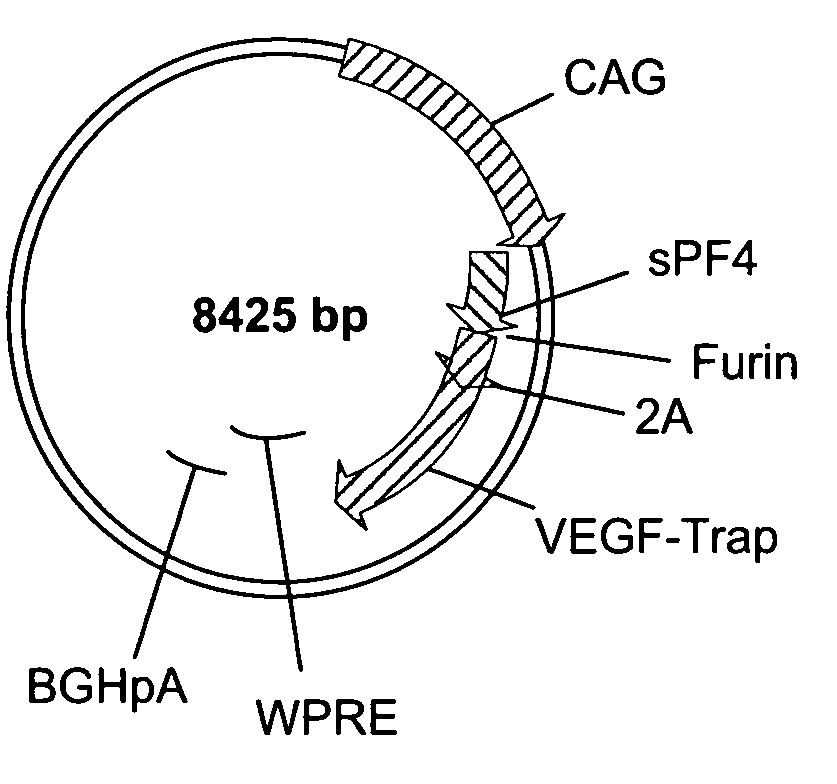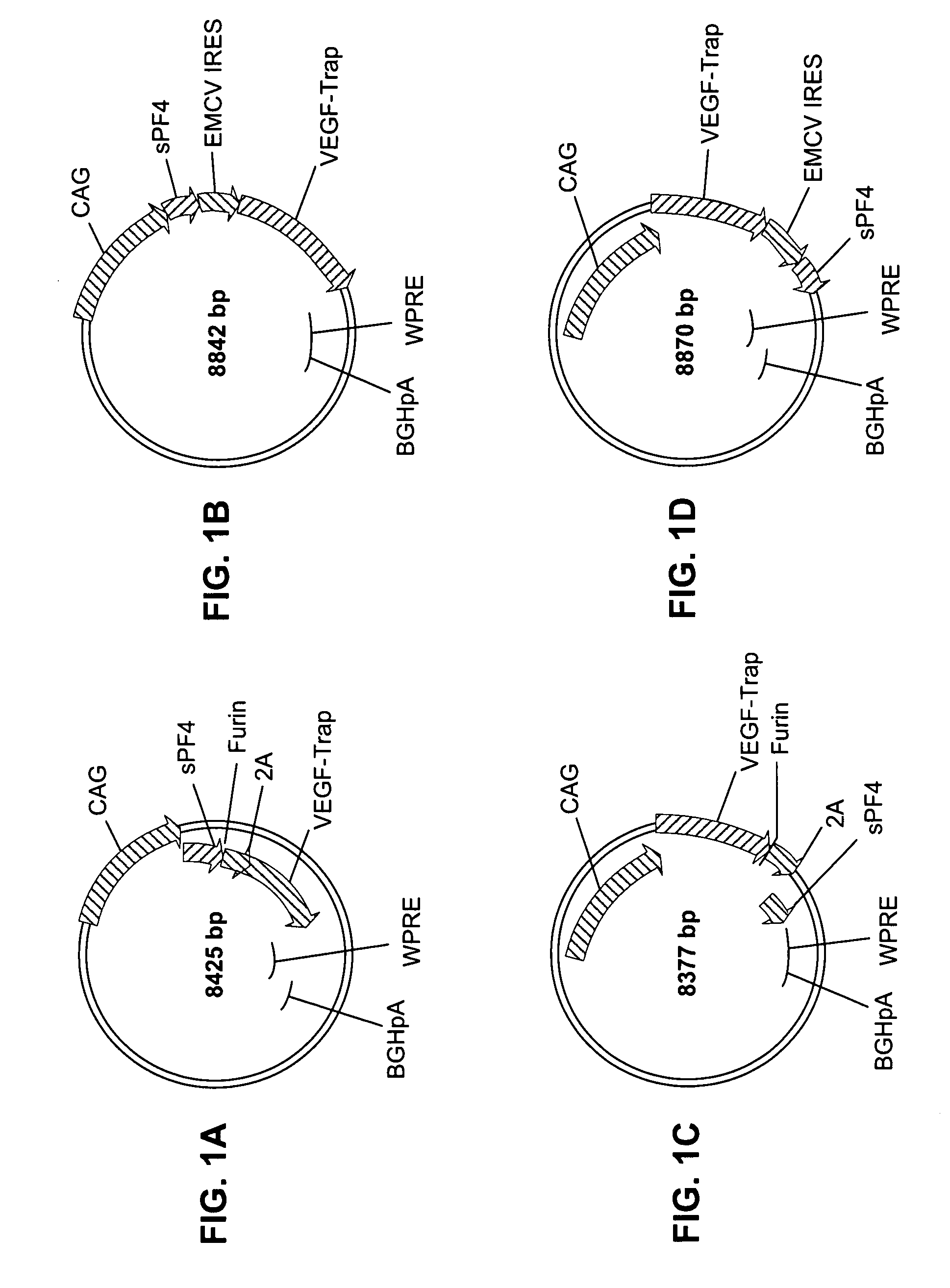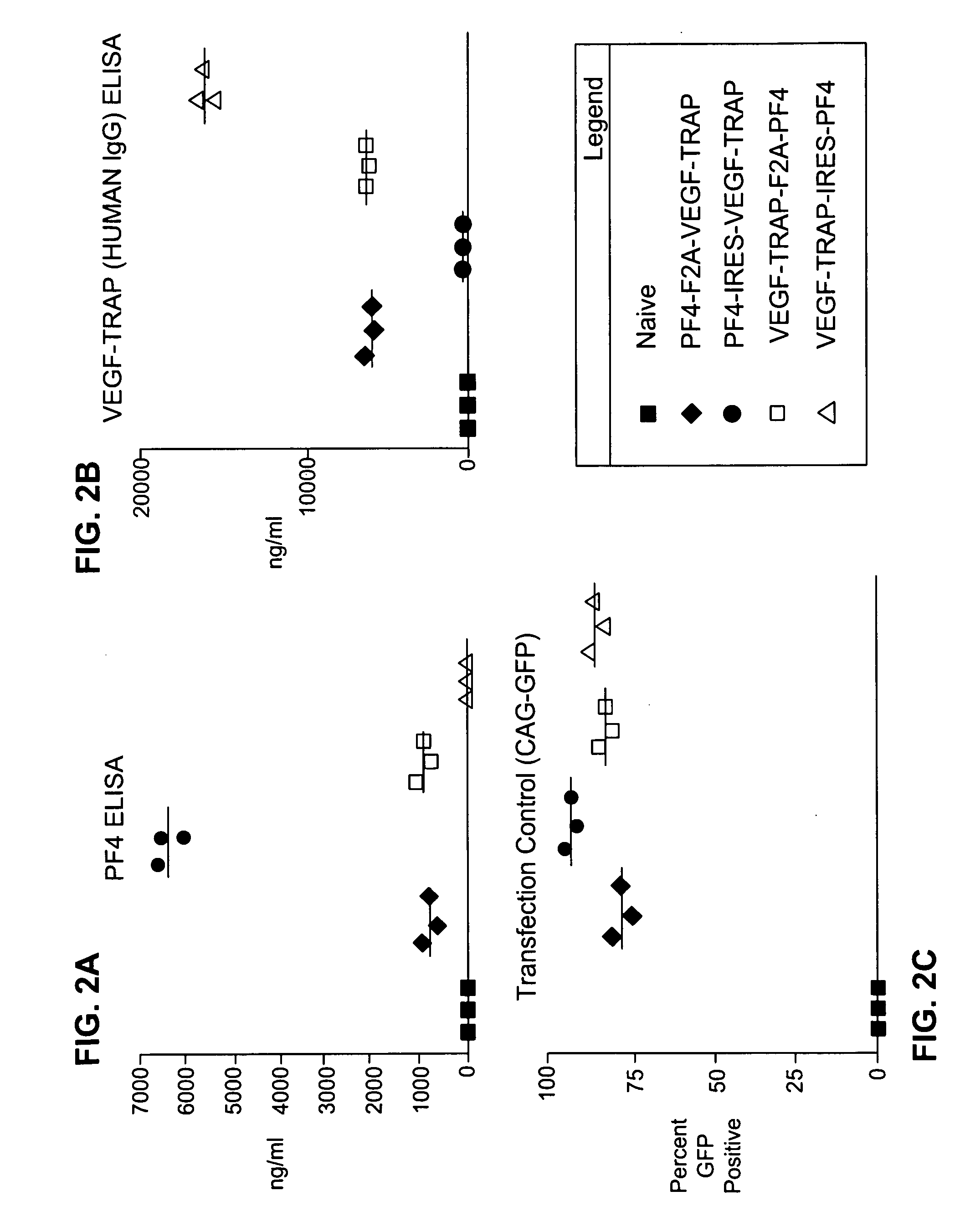Compositions and methods for enhanced expression of recombinant polypeptides from a single vector using a peptide cleavage site
a technology of recombinant polypeptides and cleavage sites, which is applied in the field of vector or plasmid constructs, can solve the problems of limiting the ability to express two or more coding sequences from a single vector, unfavorable clinical application, and high cost associated with adequate levels of expression, etc., to achieve the effect of facilitating efficient expression of two or mor
- Summary
- Abstract
- Description
- Claims
- Application Information
AI Technical Summary
Benefits of technology
Problems solved by technology
Method used
Image
Examples
example 1
Expression of Two Secreted Proteins Using the FMDV 2A and IRES Sequences
[0201]In one exemplary application of the method described herein, the coding sequences for VEGF-TRAP and platelet factor 4 (PF4) were expressed from a single promoter using either a 2A sequence or an IRES. At present, the IRES represents the state of the art for expressing two proteins from a single promoter. The purpose of this experiment was to compare the protein expression from a vector containing a 2A or 2A-like sequence to that from a vector containing an IRES. A schematic depiction of the plasmids used in this experiment is provided in FIGS. 1A-D. Vector components include the following:
CAG promoterThe cytomegalovirus enhancer / chicken beta-actin / Rabbit β-globin promoter(CAG promoter; Niwa H. et al. 1991. Gene 108(2): 193-9)2ASEQ ID NO: 14FurinSEQ ID NO: 15WPRE (Woodchuck HepatitisSEQ ID NO: 16Virus Post-TranscriptionalRegulatory Element)bGHpolyA (Bovine GrowthSEQ ID NO: 17Hormone Polyadenylation SignalSe...
example 2
Expression of Human Factor VIII from a 2A Construct
[0202]We previously demonstrated that the 2A sequence can be used to efficiently express the heavy and light chains of human and rat monoclonal antibodies. (See, e.g., U.S. Ser. No. 60 / 540,554.) In this example a 2A sequence was evaluated as for its ability to express the heavy and light chains human of Factor VIII using a single promoter. A typical Factor VIII expression construct includes a promoter, a Factor VIII heavy chain coding sequence, a furin cleavage site (RAKR), a 2A sequence, a Factor VIII light chain coding sequence, and a polyA sequence (FIG. 3). FIG. 4 shows four exemplary methods of linking the heavy and light chains of human Factor VIII to a self-processing cleavage site (e.g., 2A) with and without an additional proteolytic cleavage site (e.g., RAKR) are under evaluation. These constructs were designed to express a B domain deleted form of Factor VIII based on the ‘SQ’ B-domain deletion (Lind et al., Eur. J. Bioche...
example 3
Expression of a Rat IgG from an AAV H2AL Plasmid Transfected into 293 T Cells
[0205]An AAV plasmid (pAAV H2AL) encoding the heavy and light chain of a monoclonal IgG antibody against murine FLK-1 and linked by insertion of the FMDV 2A sequence (FIG. 6), was transiently transfected into 293T cells. Cells were grown in Iscove's Modified Dulbecco's Medium (IMDM) supplemented with 10% fetal bovine serum, 1% L-glutamine, and 1% penicillin-streptomycin solution (Invitrogen). Transfection was carried out using a FuGENE 6 transfection kit (Roche). pAAV H2AL plasmid DNA was mixed with the transfection reagent according to the manufacturer's instruction and the DNA-lipid mixture was added to the cell culture medium. The transfected cells were incubated for 48 or 72 hours and the supernatants analyzed for antibody expression. The mAb concentration was determined using a rat IgG ELISA assay (Bethyl Laboratories), in which mAb IgG protein was captured by an immobilized anti-rat IgG antibody on EL...
PUM
| Property | Measurement | Unit |
|---|---|---|
| temperature | aaaaa | aaaaa |
| length | aaaaa | aaaaa |
| compositions | aaaaa | aaaaa |
Abstract
Description
Claims
Application Information
 Login to View More
Login to View More - R&D
- Intellectual Property
- Life Sciences
- Materials
- Tech Scout
- Unparalleled Data Quality
- Higher Quality Content
- 60% Fewer Hallucinations
Browse by: Latest US Patents, China's latest patents, Technical Efficacy Thesaurus, Application Domain, Technology Topic, Popular Technical Reports.
© 2025 PatSnap. All rights reserved.Legal|Privacy policy|Modern Slavery Act Transparency Statement|Sitemap|About US| Contact US: help@patsnap.com



